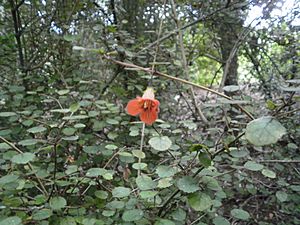Rhabdothamnus facts for kids
Rhabdothamnus solandri, also known as the New Zealand gloxinia, is a very special plant. It's the only plant in its group, called Rhabdothamnus, and the only one from the Gesneriaceae family that naturally grows in New Zealand. In the Māori language, it has other names like taurepo, matata, and waiuatua.
This plant is a small bush, or shrub, that can grow up to 2 meters (about 6.5 feet) tall. You can only find it on New Zealand's North Island. It likes to grow in different places, like forests, next to streams, or on riverbanks.
Quick facts for kids Rhabdothamnus solandri |
|
|---|---|
 |
|
| Scientific classification | |
| Genus: |
Rhabdothamnus
|
| Species: |
solandri
|
| Synonyms | |
|
|
Contents
Unique Flowers and Pollination
The New Zealand gloxinia has very interesting flowers. They are shaped like a trumpet and are a mix of red and yellow colors. These special flowers need help from birds to make seeds.
How Birds Help with Reproduction
Two types of native New Zealand birds, the bellbird and the stitchbird, are very important for this plant. When these birds visit the flowers to drink nectar, they accidentally carry pollen from one flower to another. This process is called pollination, and it's how the plant can make new seeds and grow more plants.
Why This Plant Needs Protection
Sadly, the future of the Rhabdothamnus solandri is uncertain. Many years ago, around 1870, some of the birds that pollinate this plant started to disappear from certain areas. This caused a big problem for the plant's reproduction.
The Challenge of Making Seeds
Because there are fewer of its special pollinating birds, the Rhabdothamnus solandri doesn't produce as many seeds as it used to. Even though the plant grows slowly and lives for a long time, the lack of new seeds means that over time, there will be fewer and fewer new plants. This is why it's so important to protect both the plant and the birds that help it survive.
Images for kids
See also
 In Spanish: Rhabdothamnus para niños
In Spanish: Rhabdothamnus para niños


